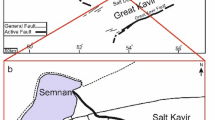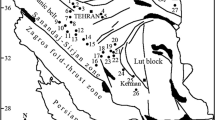Abstract
The aim of the present work is to define the geo-microbial signatures along with trace metals, and to investigate whether the geo-microbial anomalies have correlation with trace metal anomalies in Ahmedabad block of Cambay basin. The surface geochemical techniques are based on seepage of light hydrocarbon gases from the oil and gas pools to the shallow surface and can bring up near-surface oxidation reduction zones that favor the development of a diverse array of chemical and mineralogical changes. The paper reports the role of hydrocarbon microseepage in surface alterations of trace metal concentrations and hydrocarbon oxidizing bacteria and its interrelationship. For the purpose a total of 90 soil samples are collected in grid pattern of 2 x 2 km interval. The paper reports the chemical alterations associated with trace metals in soils that are related to hydrocarbon microseepages above some of the major oil and gas fields of this petroliferous region. The concentrations of V (0 to149 ppm), Cr (2 to 192 ppm), Cu (4 to 171 ppm), Se (98 to 440 ppm), Zn (56 to 1215 ppm) are obtained. It is observed that the concentrations of trace elements are tremendously increased when they are compared with their normal concentrations in soils. In this study the hydrocarbon oxidizing bacterial counts ranged between 1.0 x 103 and 1.59 x 106 cfu/g of soil sample respectively. The attempt has made for the first time, which revealed good correlation as both these anomalies are found as apical in relation. Integrated studies between trace elements and hydrocarbon oxidizing bacterial anomalies showed positive correlation with existing oil and gas wells in the study area.
Similar content being viewed by others
References
Al-Shahristani, H. and Al-Atyia, M.J. (1972) Vertical migration of oil in Iraqi oil fields: Evidence based on vanadium and nickel concentrations. Geochim. Cosmochim. Acta., v.36, pp.929–938.
Bowen, H.J.M. (1979) The Environmental Chemistry of the Elements. Academic Press, London, New York.
Clark, J.R., Reno, N.V. and Tompkins, R. (2003) Mapping of reservoirs and subsurface structures using selective analysis of the surface chemistry of soil particles. 88th Annual Meeting of AAPG (Extended Abstract), Salt Lake City, May 11-14.
Donovan, T.J. (1974) Petroleum microseepage at Cement, Oklahoma Evidence and mechanisms. AAPG Bull., v.58, pp.429–446.
Kundu, J. and Wani, M.R. (1992) Structural style and tectono stratigraphic framework of Cambay rift basin, Western India: Indian Jour. Petroleum Geol., v.86(11), pp.1891–1919.
Larriestra, F., Ferrer, F. and Larriestra, C. (2010) Geochemical Anomalies Characterization by Microbial and Trace Element Analysis related to hydrocarbon migration, Nequen Basin, Argentina. Search and Discovery (AAPG Datapages), # 40667.
Madhavi, T., Satish Kumar, T., Rasheed, M.A., Kalpana, G., Patil, D.J. and Dayal, A.M. (2009) Light hydrocarbon geochemistry of surface sediment from petroliferous region of the Mehsana Block, North Cambay Basin. Jour. Geol. Soc. India, v.74, pp.7–15.
Nimmi, Singh, Kapoor, S., Jain, A.K., Kumar, A., Mukesh Kumar and Manisha A.J. (2003) Evaluation of hydrocarbon microseepage pattern through geomicrobial survey. Proc. Petrotech, New Delhi, pp.455–458.
Nissenbaum, A. and Swaine, D.J. (1976) Organic matter-metal interactions in recent sediments, the role of humic substances. Geochem. Cosmochim Acta, v.40, pp.809–816.
Pareja, L. (1994) Combined microbial, seismic surveys predict oil and gas occurences in Bolivia. Oil and Gas Jour., v.24, pp.68–70.
Petrovic, A., Khan, S.D. and Chafetz, H.S. (2008) Remote detection and geochemical studies for finding hydrocarboninduced alterations in Lisbon Valley, Utah. Marine Petroleum Geol., v.25, pp.696–705.
Rasheed, M.A., Lakshmi, M., Srinu, D. and Dayal, A.M. (2011) Bacteria as indicators for finding oil and gas reservoirs: A case study of the Bikaner-Nagaur Basin, Rajasthan, India. Petroleum Sci., v.8, pp.264–268.
Rasheed, M.A., Lakshmi, M., Rao, P.L.S., Kalpana, M.S. and Dayal A.M. (2013) Geochemical evidences of trace metal anomalies for finding hydrocarbon microseepage in the petroliferous regions of Tatipaka and Pasarlapudi areas of Krishna Godavari Basin, India. Petroleum Sci., v.10, pp.19–29.
Rasheed, M.A., Veena, P.M., Kumar, T.S., Patil, D.J. and Dayal, A.M. (2008) Geo-microbial prospecting method for hydrocarbon exploration in Vengannapalli village, Cuddapah Basin, India. Curr. Sci., v.95(3), pp.361–366.
Rasheed, M.A., Srinivasa Rao, P.L., Anand Patil, Harshit Patel, Shubhangi Kala, Annapurna Boruah, Syed Zaheer Hasan, Rao, P.H. and Harinarayana, T. (2015) Identification of Hydrocarbon Microseepage Using Trace Metal Indicators in Petroliferous Region of South Cambay Basin, Gujarat, India. Internat. Jour. Petrol. Petrochem. Engg., v.1(1), pp.12–19.
Schumacher, D. (1996) Hydrocarbon-induced alteration of soils and sediments. In: D. Schumacher and M.A. Abrams, (Eds.), Hydrocarbon Migration and its Near-Surface Expression: AAPG Mem., no.66, pp.71–89.
Sealy, J.R. (1974) A geomicrobial method of prospecting for oil. Oil and Gas Jour., v.8, pp.142–46.
Khan, S.D. and Jacobson, S. (2008) Remote sensing and Geochemistry for detecting hydrocarbon seepages. GSA Bull., v.120, pp.96–105
Tedesco, S.A. (1995) Surface geochemistry in petroleum exploration. New York, Chapman & Hall, 256p.
Tucker, J. and Hitzman, D. (1994) Detailed microbial surveys help to improve reservoir characterization. Oil and Gas Jour., v.6, pp.65–69.
Wagner, M., Wagner, M., Piske, J. and Smit, R. (2002) Case Histories of microbial prospection for oil and gas. AAPG studies in Geology 48 and SEG Geophysical References Series, v.11, pp.453–479.
Author information
Authors and Affiliations
Corresponding author
Rights and permissions
About this article
Cite this article
Rasheed, M.A., Srinivasa Rao, P.L., Boruah, A. et al. Integrated geo-microbial and trace metal anomalies for detection of hydrocarbon microseepage in Ahmedabad block of Cambay basin, India. J Geol Soc India 88, 433–439 (2016). https://doi.org/10.1007/s12594-016-0506-6
Received:
Accepted:
Published:
Issue Date:
DOI: https://doi.org/10.1007/s12594-016-0506-6




